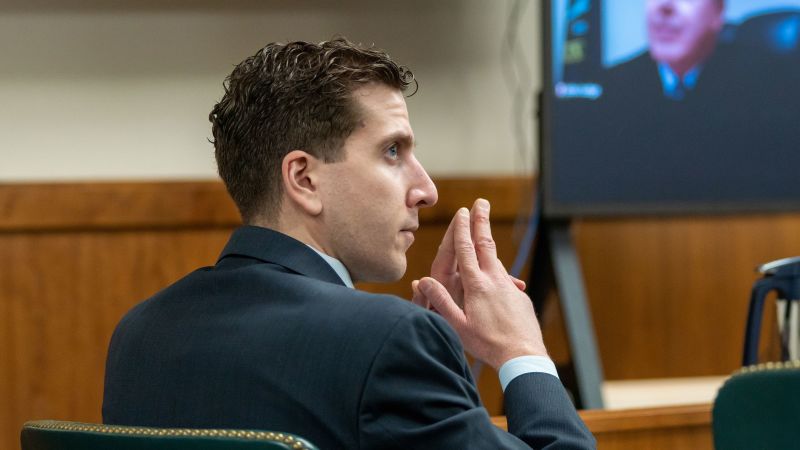In a significant development one month before his murder trial, Bryan Kohberger is anticipated to enter a plea deal regarding the 2022 killings of four Idaho college students. This agreement, expected to be discussed at a hearing on Wednesday at 11 a.m. in Boise, Idaho, could potentially remove the death penalty from consideration, as informed to the victims’ families. The hearing, presided over by state district Judge Steven Hippler, will address the plea agreement, according to a letter from the prosecutor reported by the Idaho Statesman.
Kohberger, a 30-year-old former PhD criminology student, faces charges of four counts of first-degree murder and one count of burglary in connection with the deaths that shocked the nation. The victims, Ethan Chapin, Xana Kernodle, Kaylee Goncalves, and Madison Mogen, were found dead in their off-campus home in Moscow, Idaho. As the plea deal looms, key elements of the crime remain unresolved, leaving families and the public with lingering questions.
The Case and Its Complexities
The plea deal, which at least one victim’s family has criticized, could conclude a case marked by a nationwide manhunt and extensive legal proceedings. The defense has made several attempts to dismiss the charges or remove the death penalty, but the case has persisted, drawing intense media scrutiny and public interest.
Wednesday’s hearing is expected to be straightforward, with Judge Hippler likely to confirm Kohberger’s understanding of the plea’s consequences, including potential punishments. However, the plea deal raises questions about the crime’s unresolved aspects, such as the selection of victims, the sparing of other roommates, and the method of execution and evasion.
Unanswered Questions: The Selection of Victims
Why were Goncalves, Mogen, Chapin, and Kernodle targeted? All four were students at the University of Idaho, with three sharing a residence near campus. On November 12, 2022, Goncalves posted photos on Instagram with the caption, “one lucky girl to be surrounded by these ppl everyday.” The group had gone out in Moscow that night, returning to their home where they were later found murdered.
Despite the lack of a clear connection between Kohberger and the victims, as argued by his attorney, social media activity suggests otherwise. Kohberger’s now-deleted Instagram account followed the victims, and he allegedly contacted one of the female victims repeatedly before the killings. Additionally, Kohberger visited a restaurant where two victims worked, raising further questions about potential interactions.
Why Were Two Roommates Spared?
Xana, Goncalves, and Mogen lived with two other roommates, Dylan Mortensen and Bethany Funke, who were home during the murders but unharmed. Mortensen reported hearing crying and seeing a masked figure, described as a male with bushy eyebrows, who walked past her. This encounter left Mortensen in shock, and she later texted Funke about the intruder before calling 911 to report Kernodle unconscious.
Both surviving roommates were expected to testify at Kohberger’s trial, potentially shedding light on the events of that night. Their testimonies could have provided crucial insights into the crime’s dynamics and the killer’s actions.
The Method of Execution
Under the proposed plea deal, Kohberger may not be required to disclose details of the crime. Steve Goncalves, Kaylee’s father, expressed the family’s desire for information about the murder weapon and other evidence. Moscow Police identified an “edged weapon such as a knife” as the murder tool, but only a knife sheath was found at the scene.
Kohberger’s purchase of a military-style knife and related items prior to the murders, along with a selfie taken hours after the crime, form part of the evidence. His white Hyundai Elantra, linked to the crime scene, and DNA evidence from his family’s trash further implicate him in the murders.
Implications and Future Proceedings
The plea deal, if accepted, could conclude the legal proceedings but leave many questions unanswered. The victims’ families, seeking closure, may have to wait for a sentencing hearing to express their grief and seek justice. This hearing could also provide an opportunity for new details to emerge, potentially offering some resolution to the case’s mysteries.
As the legal process unfolds, the public remains captivated by the case, reflecting broader societal concerns about safety and justice. The plea deal represents a pivotal moment in a case that has gripped the nation, highlighting the complexities and challenges of the criminal justice system.
Moving forward, the focus will likely shift to the sentencing phase and the potential for victim impact statements to influence the outcome. The case underscores the enduring impact of violent crimes on communities and the ongoing quest for answers and accountability.
About The Author
 Dolphin Echolocation: A Sensory Experience More Like Touch Than Sight
Dolphin Echolocation: A Sensory Experience More Like Touch Than Sight Texas Abortion Ban Leads to Increased Miscarriage Complications
Texas Abortion Ban Leads to Increased Miscarriage Complications Aukera Secures INR 128 Crore to Expand Lab-Grown Diamond Retail Network
Aukera Secures INR 128 Crore to Expand Lab-Grown Diamond Retail Network Breakthrough Blue Fluorophore Sets New Efficiency Records in Solid and Liquid States
Breakthrough Blue Fluorophore Sets New Efficiency Records in Solid and Liquid States Astronomers Unveil New Super-Earth Orbiting Nearby Star
Astronomers Unveil New Super-Earth Orbiting Nearby Star